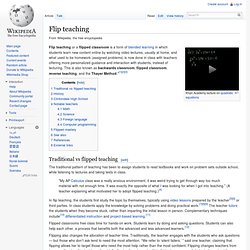

Differentiated instruction. Differentiated instruction and assessment (also known as differentiated learning or, in education, simply, differentiation) is a framework or philosophy for effective teaching that involves providing different students with different avenues to learning (often in the same classroom) in terms of: acquiring content; processing, constructing, or making sense of ideas; and developing teaching materials and assessment measures so that all students within a classroom can learn effectively, regardless of differences in ability.[1] Students vary in culture, socioeconomic status, language, gender, motivation, ability/disability, personal interests and more, and teachers need to be aware of these varieties as they are planning their curriculum.
Brain-Based Learning[edit] Differentiation finds its roots and is supported in the literature and research about the brain. Flip teaching. Flip teaching or a flipped classroom is a form of blended learning in which students learn new content online by watching video lectures, usually at home, and what used to be homework (assigned problems) is now done in class with teachers offering more personalized guidance and interaction with students, instead of lecturing.

This is also known as backwards classroom, flipped classroom, reverse teaching, and the Thayer Method. "[1][2][3] Traditional vs flipped teaching[edit] The traditional pattern of teaching has been to assign students to read textbooks and work on problem sets outside school, while listening to lectures and taking tests in class. Flipped Classroom: Flipped Talent Management Practices - K-12 Talent Manager. Flipped-classroom.jpg (JPEG Image, 1000x5184 pixels) - Scaled (12%)